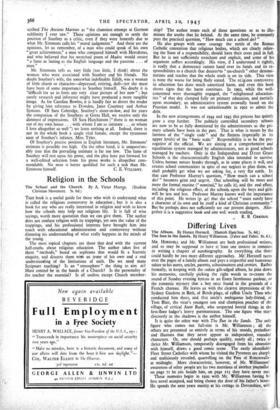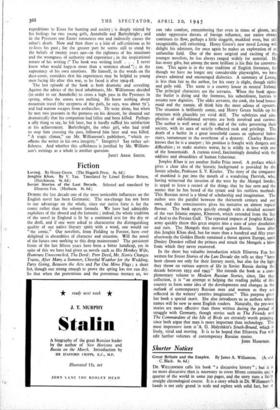Differing Lives
The Album. By Horace Horsnell. (Hamish Hamilton. 7s. 6d.) The Sun in the Sands. By Henry Williamson. (Faber and Faber. 8s. 6.1.)
MR. HORSNELL and Mr. Williamson are both professional writers, and so may be supposed to have at least one motive in common in writing a chapter of autobiography. In everything else there could hardly be two more different approaches. Mr: Horsnell turns over the pages of a family album and pays a respectful and humorous salute to his aunts, uncles, parents, schoolmasters and cronies. Rather formally, in keeping with the sedate gilt-edged album, he pins down his memories, carefully picking the right words to re-create the sound of Sunday evening hymns in an Essex farmhouse parlour, or the romantic mystery that a boy once found in the grounds of a French chateau. He leaves us with the clearest impressions of the Sydney Gardens in Bath, of Bcrck-plage, of raffish Uncle Theo who conducted him there, and that uncle's ambiguous lady-friend, of Tom Blair, the vicar's youngest son and champion poacher of the village, of critical Aunt Ruth, who suspected horrid things in the first-floor lodger's heavy portmanteaux. The one figure who stays discreetly in the shadows is the author himself.
It is quite the other way with The gun in the Sands. The only
figure who comes out full-size is Mr. Williamson ; all the others are presented so entirely in terms of his moods, prejudices and illusions that they never appear as independent, rounded
characters. Or, one should perhaps qualify, nearly all ; twice or thrice Mr. Williamson, temporarily disengaged from his obsession with himself, draws a good comic scene. The easily identifiablf Fleet Street Catholics with whom he visited the Pyrenees are sharph and maliciously revealed, quarrelling on the Pass of Roncesvalle at midnight. .More characteristic, however, of Mr. Williamson' awareness of other people are his two mentions of another journalist . on page 71 he sits beside him, on page 115 they have never met These memoirs begin in 192 with Mr. Williamson having in first novel accepted, and being shown the door of his father's house He spends the next years mainly at his cottage in Devonshire, wit! expeditions to Essex for hunting and society ; is deeply stirred by his feelings for two young girls, Annabelle and Barleybright ; and in the Pyrenees one Easter renounces one and indirectly causes the other's death. Now and then there is a hint of self-criticism as he re-lives his past ; for the greater part he seems still to stand by. the beliefs of twenty years ago—in the rightness of his intuitions and the wrongness of authority and experience ; in the inspirational nature of his writing (" The book was writing itself . . . I never knew what would happen more than a sentence ahead ") ; in the supremacy of his own emotions. He himself, in the words on the dust-cover, considers that his experiences may be helpful to young men facing life after this war, as he faced it after 1914-18.
The last episode of the book is both dramatic and revealing. Against the advice of the local inhabitants, Mr. Williamson decided (in order to see Annabelle) to cross a high pass in the Pyrenees in spring, when the snows were melting. He knew nothing about mountain travel (the steepness of the path, he says, was about 700), and had narrow escapes from avalanches. He went alone, but when he met two peasants in the pastures on his descent, he shouted out dramatically that his companion had fallen and been killed. Perhaps a silly thing to say, he felt later, but it hardly ruffled his satisfaction at his achievement. Barleybright, the other girl, who had tried to stop him crossing the pass, followed him later and was killed. "A tragic climax," say Mr. Williamson's publishers, "which re- affirms the writer in his own integrity." Integrity? Say rather sel- fishness. And whether this selfishness is justified by Mr. William- son's writings as a whole is another question.
JANET ADAM SMITH.



























 Previous page
Previous page